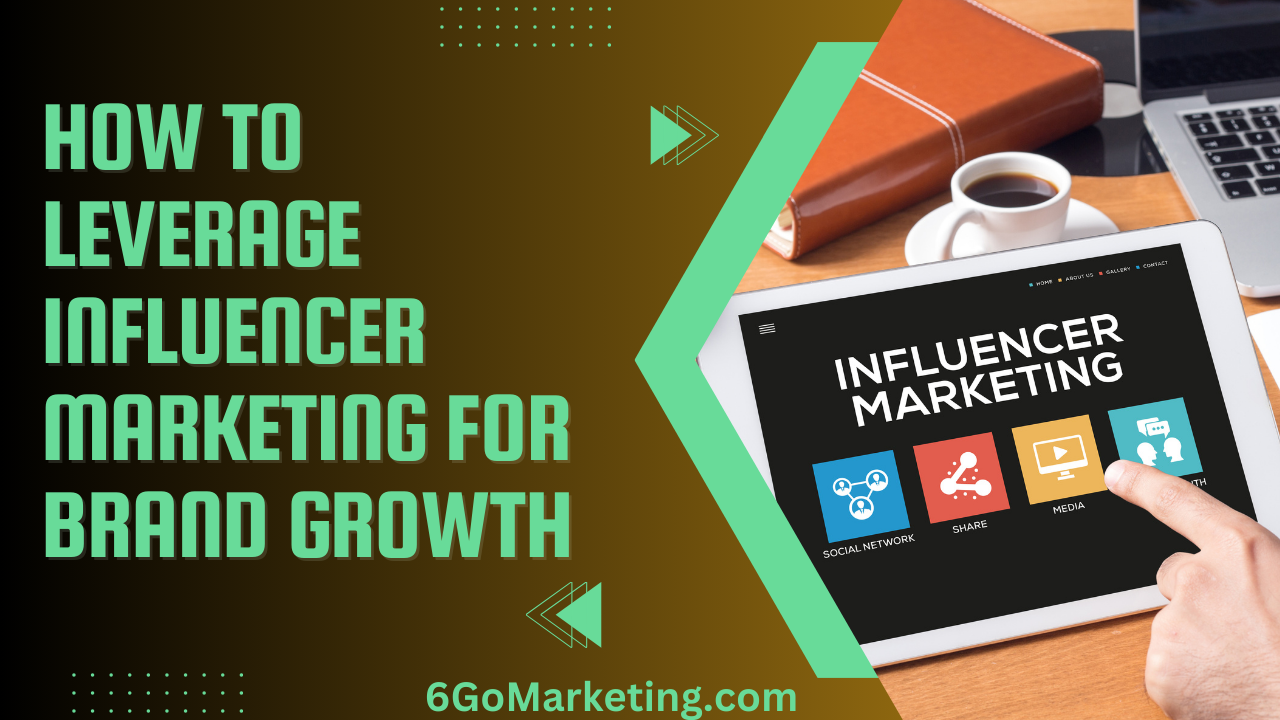In today’s digital landscape, influencer marketing has emerged as one of the most effective strategies for brand growth. With the rise of social media platforms, influencers have gained significant power to shape consumer opinions and drive purchasing decisions. Brands that effectively leverage influencer marketing can tap into new audiences, build trust, and boost their overall visibility.
This blog post will explore how to leverage influencer marketing for brand growth, from understanding the fundamentals to executing a successful campaign. We’ll cover the types of influencers, strategies for selecting the right influencers for your brand, and best practices for creating impactful collaborations. Additionally, we’ll provide real-world examples, relevant quotes, and actionable insights to help you maximize the potential of influencer marketing.
Understanding Influencer Marketing
Influencer marketing involves collaborating with individuals who have a significant online presence and influence over their followers. These influencers use their platforms to promote brands, products, or services, often through content that feels organic and authentic to their audience.
Types of Influencers
- Mega-Influencers: These are celebrities or individuals with millions of followers. They have a broad reach and are typically recognized across various demographics. While they can generate significant exposure, collaborations with mega-influencers often come with a high price tag.
- Macro-Influencers: Macro-influencers have follower counts ranging from 100,000 to 1 million. They are often industry experts, bloggers, or personalities who have built a substantial following within a specific niche. Macro-influencers offer a good balance between reach and engagement.
- Micro-Influencers: Micro-influencers have 10,000 to 100,000 followers. They are highly engaged with their audience and often have a strong influence within a particular community or niche. Micro-influencers are known for their authenticity and close relationships with their followers.
- Nano-Influencers: With fewer than 10,000 followers, nano-influencers are often everyday consumers who have built a small but loyal following. They are ideal for brands looking to connect with very specific, niche audiences on a personal level.
Quote: “Influencer marketing is not just about big names. It’s about finding the right people with the right influence to connect with your audience authentically.” — Jane Smith, Digital Marketing Expert
Example Table: Types of Influencers and Their Characteristics
| Type of Influencer | Follower Range | Characteristics | Best Used For |
|---|---|---|---|
| Mega-Influencers | 1 million+ | Wide reach, high visibility, celebrity status | Large-scale brand awareness campaigns |
| Macro-Influencers | 100,000 – 1 million | Industry experts, strong niche influence | Targeted brand exposure, industry credibility |
| Micro-Influencers | 10,000 – 100,000 | High engagement, niche community connection | Authentic brand endorsements, targeted campaigns |
| Nano-Influencers | <10,000 | Personal relationships, hyper-niche audiences | Localized or niche-specific marketing efforts |
Why Influencer Marketing is Effective
Influencer marketing has proven to be effective for several reasons. It combines the power of word-of-mouth marketing with the reach of social media, allowing brands to engage with their target audience in a more personal and authentic way.
Key Benefits of Influencer Marketing
- Builds Trust and Credibility: Influencers have established trust with their audience, and their recommendations carry weight. When an influencer endorses your brand, it can significantly enhance your credibility and foster trust among potential customers.
- Reaches Targeted Audiences: Influencers have a deep understanding of their followers, including their interests, preferences, and behaviors. This allows brands to reach highly targeted audiences, ensuring that their message resonates with the right people.
- Generates Authentic Content: Influencers create content that feels natural and aligned with their personal brand, making the promotion of your products or services more genuine. This authenticity can lead to higher engagement and better conversion rates.
- Increases Brand Awareness: Partnering with influencers, especially those with large followings, can expose your brand to a broader audience, increasing visibility and brand recognition.
- Boosts SEO and Online Presence: Influencer collaborations can generate backlinks, social shares, and mentions, all of which contribute to improving your brand’s SEO and online presence.
Example Table: Benefits of Influencer Marketing
| Benefit | Description | Impact on Brand Growth |
|---|---|---|
| Builds Trust and Credibility | Influencers’ endorsements enhance brand trust | Strengthens brand reputation, fosters customer loyalty |
| Reaches Targeted Audiences | Connects with highly specific, engaged followers | Improves campaign relevance, increases conversions |
| Generates Authentic Content | Influencers create genuine, relatable content | Enhances engagement, improves conversion rates |
| Increases Brand Awareness | Exposes the brand to a wider audience | Boosts visibility, expands reach |
| Boosts SEO and Online Presence | Generates backlinks and social shares | Improves search rankings, increases web traffic |
Steps to Leverage Influencer Marketing for Brand Growth
To effectively leverage influencer marketing for brand growth, it’s essential to approach it strategically. Below are the key steps to follow when planning and executing an influencer marketing campaign.
1. Define Your Goals and Objectives
Before diving into influencer marketing, it’s crucial to clearly define what you want to achieve. Your goals will guide your strategy and help you measure the success of your campaign. Common goals include:
- Brand Awareness: Increasing visibility and recognition for your brand.
- Lead Generation: Driving potential customers to sign up for your newsletter, download content, or take other lead-generating actions.
- Sales: Boosting sales of specific products or services.
- Social Media Growth: Increasing your brand’s social media followers, engagement, or reach.
- Content Creation: Generating high-quality content that can be repurposed across your own channels.
Example Table: Influencer Marketing Goals and Metrics
| Goal | Description | Metrics to Track |
|---|---|---|
| Brand Awareness | Increase visibility and recognition | Impressions, reach, brand mentions |
| Lead Generation | Drive potential customers to take action | Click-through rates, conversions, sign-ups |
| Sales | Boost sales of products or services | Sales volume, revenue, ROI |
| Social Media Growth | Increase followers and engagement on social media | Follower growth, likes, comments, shares |
| Content Creation | Generate high-quality, authentic content | Content engagement, content reuse value |
2. Identify and Choose the Right Influencers
Choosing the right influencers is crucial to the success of your campaign. The right influencer should align with your brand values, appeal to your target audience, and have a strong track record of engagement.
Steps to Identify the Right Influencers:
- Define Your Target Audience: Understand the demographics, interests, and behaviors of the audience you want to reach. This will help you identify influencers who have a similar audience.
- Research Influencers: Use tools like social media analytics, influencer marketing platforms, and manual research to find influencers who match your criteria.
- Evaluate Engagement: Don’t just look at follower counts; evaluate the influencer’s engagement rate, the quality of their interactions, and the authenticity of their content.
- Check for Brand Fit: Review the influencer’s past collaborations and content to ensure they align with your brand’s values and messaging.
Quote: “Finding the right influencer is like finding the perfect partner. Their audience should align with your target market, and their values should reflect your brand.” — John Doe, Influencer Marketing Specialist
Example Table: Criteria for Selecting Influencers
| Criteria | Description | Importance for Campaign Success |
|---|---|---|
| Audience Alignment | Influencer’s followers match your target audience | Ensures message resonates with the right people |
| Engagement Rate | Level of interaction with followers | Indicates the influencer’s ability to drive action |
| Content Quality | Authenticity and relevance of influencer’s content | Enhances campaign credibility, boosts engagement |
| Brand Fit | Consistency of influencer’s values with your brand | Ensures cohesive messaging, strengthens brand identity |
3. Develop a Creative Campaign Strategy
Once you’ve selected your influencers, the next step is to develop a creative campaign strategy. This involves crafting the messaging, content, and tactics that will be used to achieve your campaign goals.
Components of a Creative Campaign Strategy:
- Campaign Theme and Message: Define the central theme and key message of your campaign. Ensure it aligns with both your brand and the influencer’s voice.
- Content Guidelines: Provide influencers with guidelines on the type of content you expect, including tone, style, and any specific mentions or hashtags. However, allow them creative freedom to maintain authenticity.
- Call-to-Action (CTA): Clearly outline the action you want the audience to take, whether it’s visiting your website, making a purchase, or following your brand on social media.
- Content Calendar: Plan the timing and frequency of posts. A well-structured content calendar helps maintain consistency and keeps the campaign on track.
| Component | Description | Benefit to Campaign Execution |
|---|---|---|
| Call-to-Action (CTA) | Desired action for the audience to take | Drives engagement, increases conversions |
| Content Calendar | Schedule for content posting and promotion | Ensures consistency, maximizes reach and timing effectiveness |
4. Collaborate with Influencers and Create Content
Effective collaboration with influencers is key to producing authentic and impactful content. Building a strong relationship with influencers ensures that they feel invested in the campaign and are more likely to produce content that resonates with their audience.
Steps for Successful Collaboration:
- Set Clear Expectations: Clearly communicate your goals, content requirements, and deadlines to the influencers. This helps prevent misunderstandings and ensures that the campaign runs smoothly.
- Provide Creative Freedom: While it’s important to provide guidelines, allow influencers the creative freedom to craft content in a way that feels natural to their audience. This authenticity is what drives engagement.
- Regular Communication: Maintain open lines of communication throughout the campaign. Regular check-ins help address any concerns and keep the campaign on track.
- Offer Support: Provide influencers with the resources they need, whether it’s product samples, brand assets, or information about your brand. The more equipped they are, the better the content they can produce.
Quote: “The best influencer collaborations are those where the brand and influencer work together seamlessly, respecting each other’s strengths and creating content that feels genuine and engaging.” — Emma Brown, Content Strategist
Example Table: Best Practices for Collaborating with Influencers
| Practice | Description | Benefit to Collaboration |
|---|---|---|
| Set Clear Expectations | Communicate goals, content requirements, and deadlines | Prevents misunderstandings, ensures alignment |
| Provide Creative Freedom | Allow influencers to create content in their own style | Enhances authenticity, boosts audience engagement |
| Regular Communication | Maintain open, ongoing dialogue with influencers | Addresses concerns promptly, keeps campaign on track |
| Offer Support | Provide necessary resources and information | Empowers influencers, improves content quality |
5. Launch and Promote the Campaign
Once the content is ready, it’s time to launch and promote the campaign. This step involves coordinating the rollout of content across the influencer’s platforms and amplifying the reach through additional marketing efforts, including strategies like buying TikTok followers to boost visibility and engagement.
Steps for a Successful Campaign Launch:
- Coordinate Launch Timing: Ensure that the content is posted at optimal times for maximum visibility and engagement. Collaborate with influencers to agree on the best timing.
- Use Hashtags and Tags: Encourage influencers to use branded hashtags and tag your brand in their posts. This increases discoverability and helps track campaign performance.
- Amplify with Paid Media: Consider boosting the influencer’s posts with paid social media ads to reach a wider audience. This can significantly increase the campaign’s reach and impact.
- Cross-Promote on Brand Channels: Share influencer content on your brand’s social media channels, website, and email newsletters. This not only amplifies the content but also provides social proof to your audience.
Example Table: Campaign Launch and Promotion Tactics
| Tactic | Description | Benefit to Campaign Success |
|---|---|---|
| Coordinate Launch Timing | Schedule posts at optimal times for visibility | Maximizes engagement, ensures broad reach |
| Use Hashtags and Tags | Utilize branded hashtags and tags in posts | Enhances discoverability, simplifies tracking |
| Amplify with Paid Media | Boost influencer posts with paid ads | Increases reach, drives additional engagement |
| Cross-Promote on Brand Channels | Share content on brand’s own platforms | Strengthens brand credibility, increases exposure |
6. Measure and Analyze Campaign Performance
Measuring the success of your influencer marketing campaign is crucial to understanding its impact and refining future efforts. By analyzing key metrics, you can assess whether the campaign met its objectives and provided a good return on investment (ROI).
Key Metrics to Track:
- Engagement Rate: Measure the likes, comments, shares, and overall interaction on the influencer’s posts. High engagement indicates that the content resonated with the audience.
- Reach and Impressions: Track how many people were exposed to the campaign. This helps assess the campaign’s overall visibility.
- Click-Through Rate (CTR): Monitor the number of people who clicked on the links included in the influencer’s content. This metric is crucial for campaigns focused on driving traffic or conversions.
- Conversion Rate: Measure the percentage of people who completed a desired action, such as making a purchase or signing up for a newsletter, after engaging with the influencer’s content.
- ROI: Calculate the return on investment by comparing the revenue generated from the campaign to the costs involved. A positive ROI indicates a successful campaign.
Quote: “The real power of influencer marketing lies in its ability to drive measurable results. By analyzing the right metrics, you can fine-tune your strategy and maximize your impact.” — Mark Thompson, Digital Marketing Analyst
Example Table: Metrics for Measuring Influencer Marketing Success
| Metric | Description | Importance for Campaign Evaluation |
|---|---|---|
| Engagement Rate | Measures interaction with the content | Indicates content resonance, predicts viral potential |
| Reach and Impressions | Tracks the number of people exposed to the campaign | Assesses overall visibility and awareness |
| Click-Through Rate (CTR) | Monitors clicks on links within the content | Evaluates effectiveness in driving traffic |
| Conversion Rate | Percentage of audience taking the desired action | Measures success in achieving campaign objectives |
| Return on Investment (ROI) | Compares revenue generated to campaign costs | Determines financial success, justifies investment |
7. Build Long-Term Relationships with Influencers
Building long-term relationships with influencers can lead to more authentic collaborations and better results over time. Influencers who have an ongoing relationship with your brand are more likely to become genuine advocates, which can have a lasting impact on your brand’s growth.
Steps to Build Long-Term Relationships:
- Follow-Up and Feedback: After the campaign, follow up with influencers to provide feedback, share results, and discuss potential future collaborations.
- Maintain Regular Communication: Keep in touch with influencers even when you’re not actively running a campaign. This helps build a stronger connection and keeps your brand top of mind.
- Offer Exclusive Opportunities: Provide long-term influencers with exclusive offers, early access to new products, invitations to corporate events, or other special occasions. or invitations to special events. This makes them feel valued and strengthens their loyalty to your brand.
- Involve Influencers in Product Development: Engage influencers in the development or testing of new products. Their insights can be valuable, and their involvement can lead to more authentic promotion.
Example Table: Strategies for Building Long-Term Influencer Relationships
| Strategy | Description | Benefit to Brand Growth |
|---|---|---|
| Follow-Up and Feedback | Provide feedback and discuss future collaborations | Encourages ongoing partnership, improves future campaigns |
| Maintain Regular Communication | Stay in touch between campaigns | Builds stronger connections, keeps brand top of mind |
| Offer Exclusive Opportunities | Give influencers special offers or early access | Strengthens loyalty, enhances relationship quality |
| Involve in Product Development | Engage influencers in testing or development | Gains valuable insights, fosters authentic promotion |
Real-World Examples of Successful Influencer Marketing
Examining real-world examples can provide valuable insights into how brands have successfully leveraged influencer marketing to drive growth.
1. Daniel Wellington
Campaign Overview: Daniel Wellington, a watch brand, became a global success by partnering with influencers to promote its products. Instead of relying on traditional advertising, the brand sent its watches to influencers around the world and encouraged them to share photos with a specific hashtag.
Key Success Factors:
- Micro-Influencer Focus: Daniel Wellington targeted micro-influencers with engaged audiences, which helped create a more authentic and relatable brand image.
- User-Generated Content: The hashtag campaign generated a wealth of user-generated content, which the brand could repurpose across its own channels.
- Consistency: By consistently working with influencers, the brand maintained a steady stream of content and built strong brand recognition.
Result: Daniel Wellington saw rapid growth, with the brand reportedly selling over a million watches within three years of launching its influencer marketing strategy.
2. Glossier
Campaign Overview: Glossier, a beauty brand, has built its success largely on influencer marketing and community engagement. The brand collaborates with influencers, as well as everyday customers, to promote its products through authentic, user-generated content.
Key Success Factors:
- Customer-Centric Approach: Glossier empowers its customers to become brand ambassadors, creating a sense of community and trust.
- Diverse Influencer Partnerships: The brand works with a diverse range of influencers, from beauty gurus to lifestyle bloggers, to reach different segments of its target audience.
- Focus on Authenticity: Glossier’s campaigns are known for their authenticity, with influencers sharing their genuine experiences with the products.
Result: Glossier’s influencer marketing strategy has helped the brand achieve significant growth, with a loyal customer base and a strong online presence.
3. Adidas (continued)
Key Success Factors:
- High-Profile Collaborations: Adidas collaborated with high-profile influencers and celebrities, generating buzz and excitement around the product launch. Influencers like Kanye West and Pharrell Williams were instrumental in creating hype for the brand’s sneaker lines, making them highly desirable among target audiences.
- Exclusive Content: Adidas provided influencers with early access to products and exclusive content, which they shared with their followers. This strategy not only built anticipation but also made the followers feel like they were getting an insider’s look into the brand.
- Social Media Amplification: Adidas utilized the power of social media to amplify its influencer campaigns. By encouraging influencers to use specific hashtags and engage with their followers, Adidas maximized the reach and impact of its campaigns across platforms like Instagram and Twitter.
Result: The influencer marketing strategy significantly boosted Adidas’s brand visibility and sales. The NMD sneaker line, for example, became a cultural phenomenon, selling out quickly and contributing to Adidas’s strong growth in the competitive sneaker market.
Challenges in Influencer Marketing and How to Overcome Them
While influencer marketing offers numerous benefits, it also comes with its own set of challenges. Understanding these challenges and knowing how to address them can help you execute more effective campaigns.
1. Identifying the Right Influencers
Challenge: Finding influencers who align with your brand and have genuine influence over their audience can be difficult. The wrong choice can result in low engagement or even damage to your brand’s reputation.
Solution: Conduct thorough research using influencer marketing platforms, social media analytics, and manual investigation to ensure that the influencers you choose are a good fit. Evaluate their content, engagement rates, and audience demographics carefully before making a decision.
2. Measuring ROI
Challenge: Calculating the return on investment (ROI) for influencer marketing can be complex, especially when trying to attribute sales or conversions directly to influencer activity.
Solution: Set clear objectives and metrics before launching your campaign. Use tracking tools like UTM parameters, affiliate links, and promo codes to measure the impact of influencer posts. Additionally, monitor engagement metrics, website traffic, and sales data to get a comprehensive view of your campaign’s performance.
3. Ensuring Authenticity
Challenge: As influencer marketing becomes more widespread, audiences are becoming savvier and can easily detect inauthentic promotions. If an influencer’s endorsement doesn’t feel genuine, it can lead to skepticism and disengagement.
Solution: Collaborate closely with influencers to ensure that their content aligns with both their personal brand and your brand’s message. Allow influencers the creative freedom to craft content that feels natural and authentic to their audience. Avoid overly scripted content that may come across as forced or insincere.
4. Managing Compliance and Disclosure
Challenge: With the rise of influencer marketing, regulatory bodies like the FTC (Federal Trade Commission) have introduced guidelines requiring influencers to disclose paid partnerships. Failure to comply can result in fines and damage to your brand’s reputation.
Solution: Educate influencers about the importance of compliance and ensure that they use clear and conspicuous disclosures in their posts, such as #ad or #sponsored. Include these requirements in your agreements with influencers and regularly monitor their posts to ensure adherence.
Example Table: Common Challenges in Influencer Marketing and Solutions
| Challenge | Description | Solution |
|---|---|---|
| Identifying the Right Influencers | Difficulty finding influencers who align with your brand | Conduct thorough research and vetting processes |
| Measuring ROI | Challenges in attributing sales or conversions | Set clear metrics, use tracking tools, and analyze comprehensive data |
| Ensuring Authenticity | Risk of inauthentic promotions turning off audiences | Collaborate closely, provide creative freedom, avoid overly scripted content |
| Managing Compliance and Disclosure | Navigating regulations and disclosure requirements | Educate influencers, include clear disclosure guidelines, monitor posts for compliance |
Future Trends in Influencer Marketing
As the digital landscape continues to evolve, so too does influencer marketing. Staying ahead of emerging trends can help brands maintain competitive intelligence and maximize the impact of their influencer partnerships.
1. Rise of Micro and Nano-Influencers
Micro and nano-influencers are becoming increasingly popular due to their high engagement rates and authentic connections with niche audiences. Brands are expected to continue leveraging these influencers for more targeted and cost-effective campaigns.
2. Focus on Video Content
With the growing popularity of platforms like TikTok and Instagram Reels, video content is becoming a dominant format in influencer marketing. Short, engaging videos offer a dynamic way to showcase products and connect with audiences.
3. Increased Emphasis on Long-Term Partnerships
Brands are shifting towards building long-term relationships with influencers rather than one-off campaigns. This approach fosters deeper connections, ensures consistency, and turns influencers into genuine brand advocates.
4. Integration of AI and Data Analytics
AI and data analytics are playing a larger role in influencer marketing by helping brands identify the right influencers, predict campaign outcomes, and measure effectiveness with greater accuracy. This trend will likely continue as technology advances.
5. Authenticity and Transparency
As consumers become more discerning, authenticity and transparency will be critical in influencer marketing. Brands that prioritize genuine relationships and clear communication with their audiences will be more successful in building trust and driving engagement.
Example Table: Emerging Trends in Influencer Marketing
| Trend | Description | Impact on Influencer Marketing |
|---|---|---|
| Rise of Micro and Nano-Influencers | Increasing popularity due to high engagement | More targeted and cost-effective campaigns |
| Focus on Video Content | Growing use of short-form video platforms | Dynamic, engaging content that resonates with audiences |
| Long-Term Partnerships | Shift towards sustained collaborations with influencers | Deeper connections, consistent brand messaging |
| AI and Data Analytics | Use of technology to optimize influencer marketing | More precise influencer selection, improved campaign performance |
| Authenticity and Transparency | Demand for genuine and honest influencer relationships | Builds trust, fosters long-term brand loyalty |
Conclusion
Influencer marketing has proven to be a powerful tool for brand growth, offering the ability to connect with audiences in an authentic and impactful way. By strategically selecting the right influencers, developing creative campaigns, and measuring performance, brands can leverage influencer marketing to achieve a range of goals, from increasing brand awareness to driving sales.
As the influencer landscape continues to evolve, staying informed about emerging trends and best practices will be crucial for maximizing the potential of your influencer marketing efforts. Whether you’re collaborating with mega-influencers or building relationships with nano-influencers, the key to success lies in authenticity, strategic planning, and continuous optimization.
Quote: “Influencer marketing is not just about reaching people; it’s about reaching the right people in a way that resonates. When done right, it can transform a brand’s presence and drive meaningful growth.” — Sarah Thompson, Marketing Director
By embracing influencer marketing as a core component of your digital strategy, you can tap into new audiences, build trust, and ultimately drive sustained brand growth in today’s competitive market.









